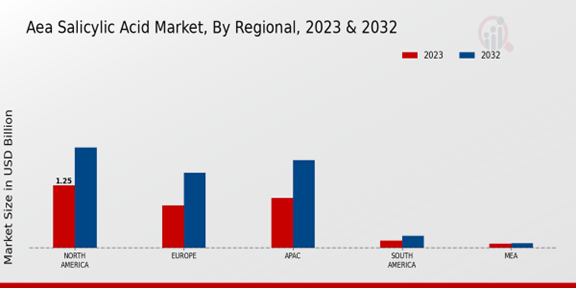Growing Awareness of Skin Health
There is a growing awareness of skin health among consumers, which significantly influences the Global AEA Salicylic Acid Market Industry. Educational campaigns and social media have heightened consumer knowledge regarding the benefits of salicylic acid in maintaining skin clarity and health. This awareness is driving the demand for products that feature salicylic acid as a key ingredient. As consumers prioritize skincare routines, the market is likely to see sustained growth, with a projected CAGR of 5.48% from 2025 to 2035. This trend indicates a shift towards proactive skincare, where individuals invest in products that promote long-term skin health.
Rising Demand for Acne Treatment
The increasing prevalence of acne among adolescents and adults drives the Global AEA Salicylic Acid Market Industry. Salicylic acid is recognized for its efficacy in treating acne due to its ability to penetrate pores and exfoliate the skin. In 2024, the market is projected to reach 3.72 USD Billion, reflecting a growing consumer awareness regarding skincare. The rise in acne cases, coupled with the popularity of skincare products containing salicylic acid, suggests a robust demand trajectory. This trend is likely to continue as more individuals seek effective solutions for acne management, thereby bolstering the market further.
Expansion of Skincare Product Lines
The Global AEA Salicylic Acid Market Industry is experiencing a notable expansion in skincare product lines that incorporate salicylic acid. Major cosmetic brands are increasingly formulating cleansers, toners, and moisturizers with this ingredient, appealing to consumers seeking multifunctional products. This diversification not only enhances product offerings but also caters to a broader audience, including those with sensitive skin. As the market evolves, it is anticipated that the introduction of innovative formulations will contribute to the projected growth, with the market expected to reach 6.69 USD Billion by 2035. This expansion reflects a strategic response to consumer preferences for effective and gentle skincare solutions.
Regulatory Support for Cosmetic Ingredients
Regulatory support for cosmetic ingredients, including salicylic acid, plays a pivotal role in shaping the Global AEA Salicylic Acid Market Industry. Governments and regulatory bodies are establishing guidelines that promote the safe use of salicylic acid in cosmetic formulations. This regulatory framework not only ensures consumer safety but also encourages manufacturers to innovate and expand their product lines. As regulations evolve, they are likely to facilitate market entry for new products, thereby enhancing competition and variety in the market. This supportive environment is expected to contribute positively to the market's growth trajectory in the coming years.
Increased Investment in Research and Development
The Global AEA Salicylic Acid Market Industry is witnessing increased investment in research and development, leading to enhanced product formulations and applications. Companies are focusing on developing innovative delivery systems and combinations with other active ingredients to improve efficacy and consumer experience. This investment is crucial as it not only drives product differentiation but also addresses specific skin concerns, such as aging and hyperpigmentation. The ongoing R&D efforts are expected to contribute to the market's growth, as consumers increasingly seek advanced solutions tailored to their unique skin needs, thereby expanding the overall market landscape.




















Leave a Comment